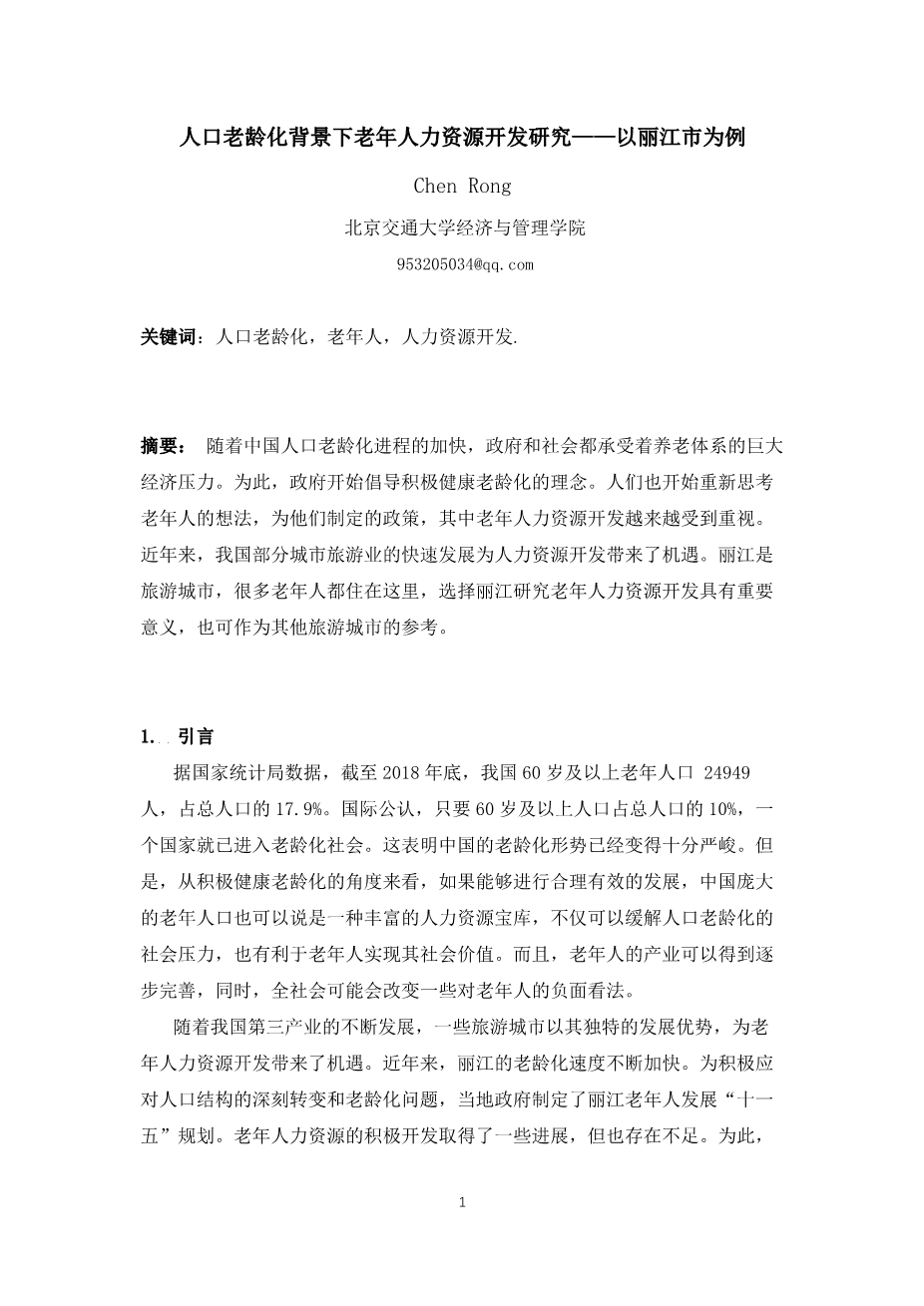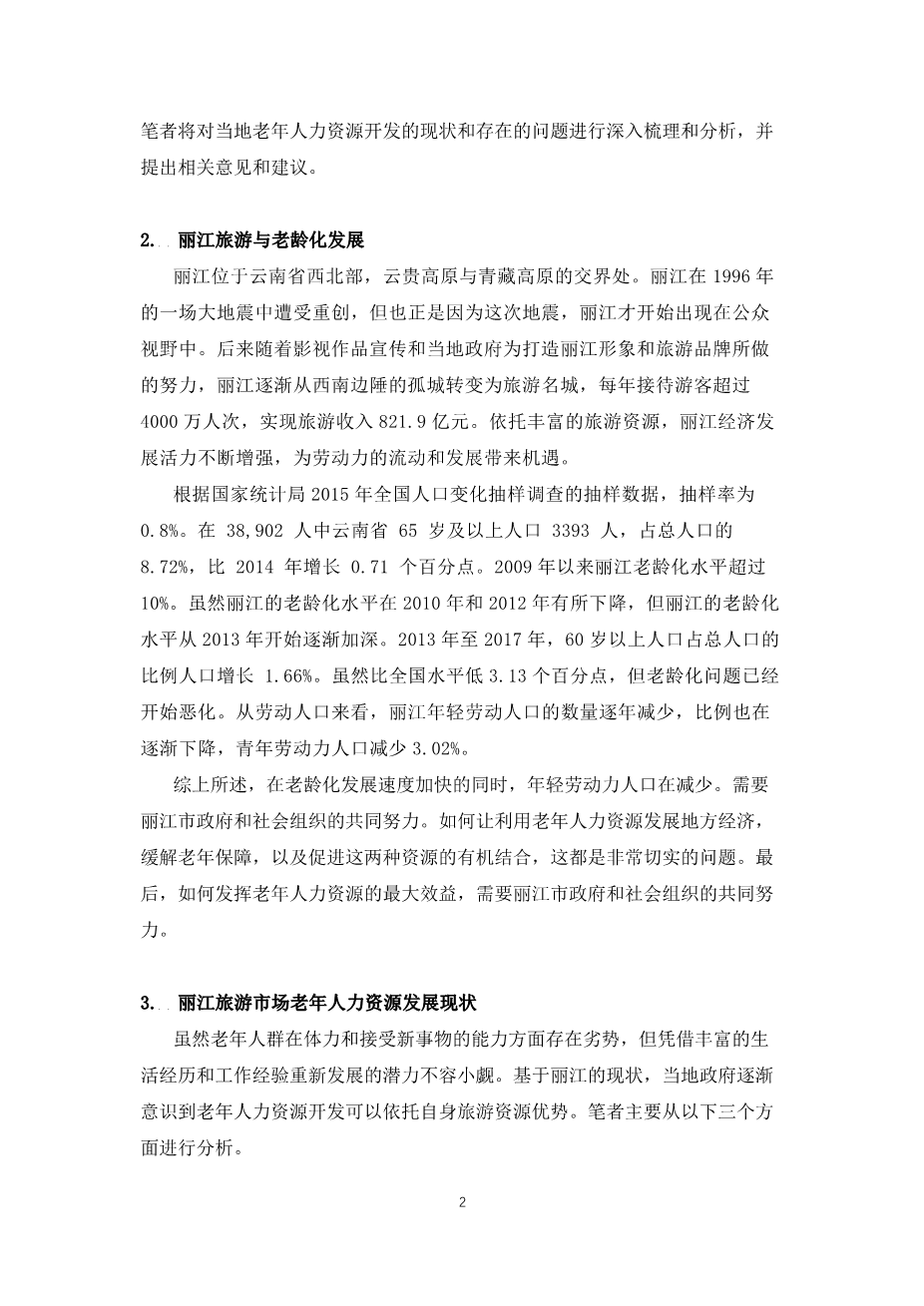人口老龄化背景下老年人力资源开发研究——以丽江市为例外文翻译资料
2023-04-18 18:28:45
Advances in Economics, Business and Management Research, volume 118
International Conference on Management Science and Industrial Economy (MSIE 2019)
Research on the development of Elderly Human Resources in the
population aging- a case study of Lijiang
Chen Rong1,a
1School of Economics and Management, Beijing Jiaotong University, Beijing, China 953205034@qq.coma
Key words: Population aging, Older adults, Human resource development.
Abstract. With the acceleration of population aging in China, the government and society are under great economic pressure of elderly support system. To this end, the government began to advocate the concept of active and healthy aging. People also begin to rethink the view of the elderly and the policy designed for them, among which the development of elderly human resources has received more and more attention. In recent years, some cities in China, the rapid development of the tourism industry brought opportunities for the development of human resources. Lijiang is a tourist city and many older adults live here, so it is of great significance to choose Lijiang to study the development of elderly human resource. This is also a reference for other tourist cities.
1. Introduction
By the end of 2018, according to the data from the national bureau of statistics, there were 249.49 million people aged 60 or above in China, accounting for 17.9 percent of the total population. However, it is internationally recognized that a country has entered an aging society as long as the population aged 60 or above accounts for 10 percent of the total population. This indicates that the aging situation in China has become very severe [1].However, from the point of view of positive and healthy aging, if reasonable and effective development can be carried out, huge elderly population in China also can be regarded as a kind of abundant human resources treasure, which can not only alleviate the social pressure of population aging, but also conducive to the elderly to realize its social value. Moreover, the industry of the elderly can be gradually improved, and at the same time, the whole society may change some negative views on the elderly.
With the continuous development of tertiary industry in China, some tourism cities have brought opportunities for the development of human resources for the elderly due to their unique development advantages. In recent years, the aging rate of Lijiang has been accelerated. In order to actively deal with the profound transformation of population structure and the aging problem, the local government has formulated the 'eleventh five-year plan' for the development of the elderly in Lijiang. There has been some progress in the positive development of human resources for the elderly, but there are also shortcomings. Therefore, the author will deeply sort out and analyze the current situation and existing problems of local elderly human resources development, and put forward relevant opinions and suggestions.
2. Tourism and aging development in Lijiang
Lijiang is located at the junction of Yunnan-Kweichow Plateau and Qinghai-Tibet Plateau, in the northwest of Yunnan province. Lijiang was badly hit by a big earthquake in 1996, but it was also because of this earthquake that Lijiang began to appear in the public eye. Later, with the propaganda of film and television literature works and the efforts of the local government to build the image and tourism brand of Lijiang. Lijiang gradually changed from an isolated city on the southwest border into a famous tourism city with over 40 million tourists and tourism revenue of 82.19 billion yuan every year. Relying on its rich tourism resources, the economic development vitality of Lijiang keeps increasing, bringing opportunities for the flow and development of labor force.
According to the sample data of the national population change sampling survey conducted by the national bureau of statistics in 2015, the sampling ratio was 0.8 percent. Among the 38,902 people
Copyright copy; 2020 The Authors. Published by Atlantis Press SARL.
This is an open access article distributed under the CC BY-NC 4.0 license (http://creativecommons.org/licenses/by-nc/4.0/)
281
Advances in Economics, Business and Management Research, volume 118
sampled in Yunnan province, 3,393 were aged 65 or above, accounting for 8.72 percent of the total population, an increase of 0.71 percent compared with the data in 2014. In terms of the proportion of 60-year-olds in the total population, the aging level of Lijiang has exceeded 10 percent since 2009.Although the aging level of Lijiang declined in 2010 and 2012, the aging level of Lijiang has gradually deepened since 2013. From 2013 to 2017, the proportion of 60-year-olds in the total population rose by 1.66 percent. Although 3.13 percent lower than the national level, the aging problem has begun to worsen (Fig.1). From the perspective of working population, the number of young working population in Lijiang has been decreasing year by year, and the proportion has been decreasing gradually likewise. The number of youth labor force population decreased by 3.02 percent from 2009 to 2017(Table.1).
16.00%
14.00%
12.00%
10.00%
8.00%
6.00%
4.00%
2.00%
0.00%
12.95%
12.47%
12.81% 12.53%
13.11%
13.87%
14.20%
14.61% 14.77%
2009 2010 2011 2012 2013 2014 2015 2016 2017
Figure 1. The change of the proportion of 60 population in the total population of Lijiang from 2009 to 2017 (%)
(The data are from statistical yearbook 2010-2018 and statistics bureau of Lijiang)
Table 1. Changes of the proportion of youth labor force popul
剩余内容已隐藏,支付完成后下载完整资料


英语译文共 7 页,剩余内容已隐藏,支付完成后下载完整资料
资料编号:[588773],资料为PDF文档或Word文档,PDF文档可免费转换为Word




